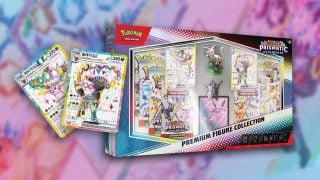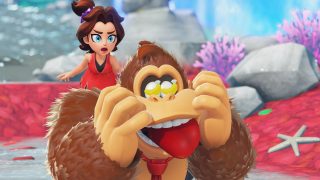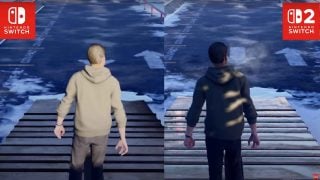Sometimes it feels like just yesterday that specific Legend of Zelda games were released. I still have incredibly vivid memories of seeing commercials in movie theaters for Ocarina of Time or getting unreasonably hyped up for both Oracle games after watching some cartoons. Those moments are seared into my mind because of how much Nintendo’s revered series means to me. I can practically recount exactly what I was doing and what I was wearing when I first heard of each of these specific games.
The Legend of Zelda: The Wind Waker, however, didn’t have the warmest of receptions upon its initial reveal. I distinctly remember that infamous Space World 2000 demo with “realistic” versions of Link and Ganondorf, so fan perception was that the next game for Nintendo’s purple lunchbox was going to be a darker and edgier installment. Instead, the world was introduced to Toon Link and his cute winking animation. While I personally didn’t think much of that shift in style, the internet exploded with rage and deemed that The Legend of Zelda was dead.
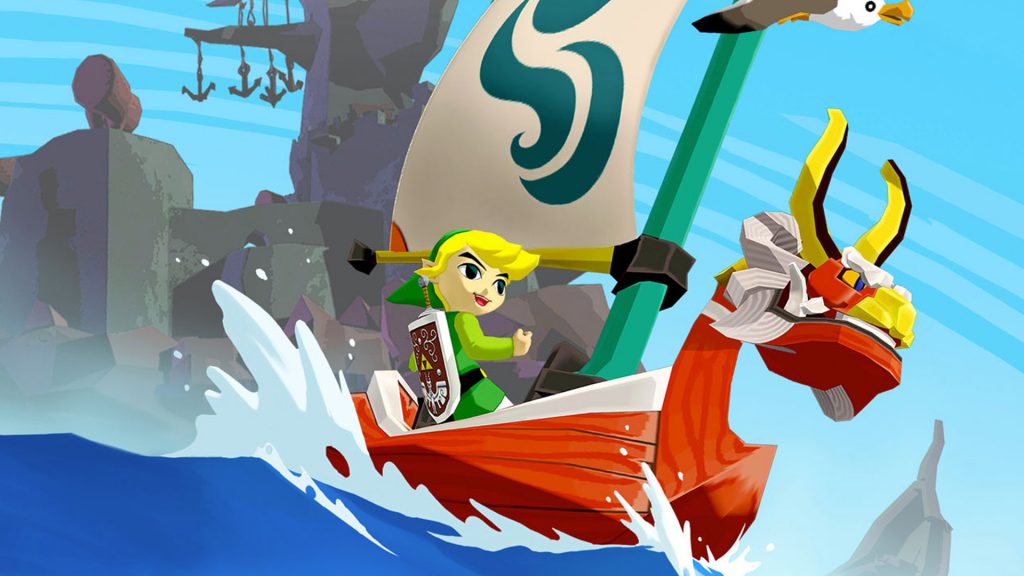
Funny how 21 years later (technically 22 from that reveal), The Wind Waker is considered one of the best — if not the best — the series has to offer. For most Americans, we didn’t get our taste of cel-shaded Zelda goodness until 2003, but reactions from Japan in the meantime were all positive. There weren’t many games on the ill-fated GameCube that sold particularly well, but it seemed like Japanese fans were enthralled with Nintendo’s newest adventure. How would North Americans respond?
Sadly, it wasn’t nearly as kind.
In the years since we’ve learned that the development of a potential The Wind Waker 2 was cancelled because players in the US responded so divisively to Link’s Saturday morning makeover. Twilight Princess even came about to appease Western audiences, which helped that game become the highest-selling in the series up to that point. As for The Wind Waker, it was seen as a bizarre deviation from what Nintendo “should” be doing with the series. I often wonder if the North American pre-order bonus of Ocarina of Time’s Master Quest was a way to placate those diehard fans.
Me, though? It said Zelda on the box, so I was there. I rushed to my GameStop the same day as that reveal and asked about making a pre-order. While it was too early to do so (stupid computers), I couldn’t wait to get my hands on the game. I hadn’t yet become jaded by the industry and its incessant need to pump out endless sequels, so I welcomed yet another Zelda title. That it looked like a cartoon was honestly very charming to me.
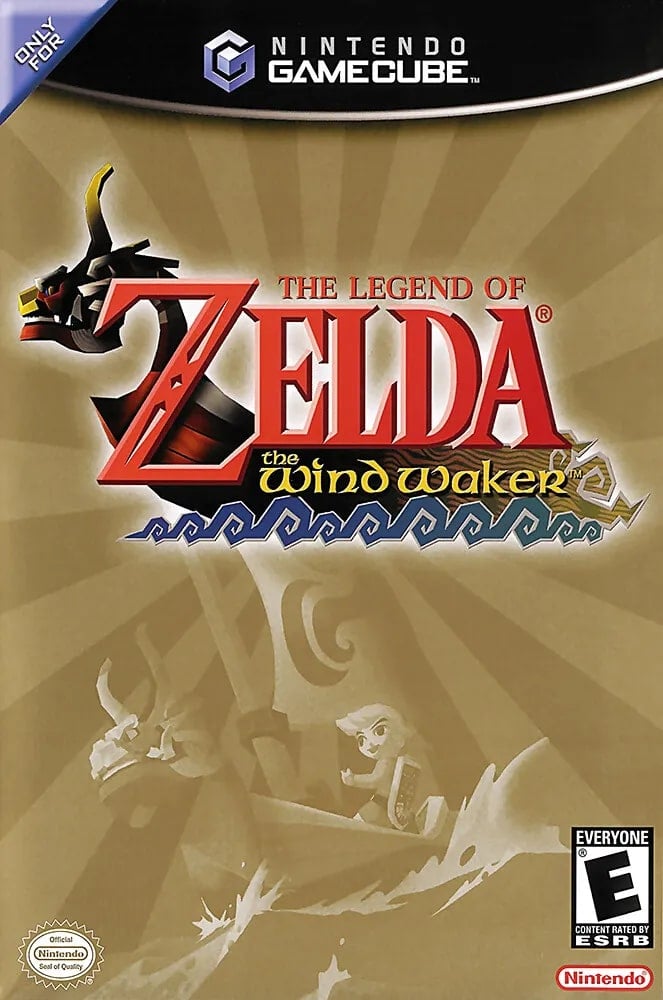
When I finally got my hands on the game, I think I let my friend’s reaction skew my perspective too much. To him, Master Quest was the true reason to buy this and The Wind Waker was just a pale imitation of Ocarina of Time. I finished the first dungeon of the game and shelved The Wind Waker for a few years. It wasn’t until after Twilight Princess was released that I decided I would make it my quest to finish every Legend of Zelda game to understand why it had become such a favorite of mine in my youth. That journey would not only strengthen my love for Nintendo’s fantasy series, but it would also lead me to understand why The Wind Waker was such a radical departure for Zelda.
Apart from the obvious visual overhaul, one of the most interesting aspects of The Wind Waker is that it was the first time Nintendo gave Link some history. In all previous games, the story took something of a backseat, but Link was typically an orphan or a pre-destined hero. He always wanted to save Princess Zelda and Link was kind to the various NPCs, but there was no true history of his own. In The Wind Waker, Link has a grandmother and a sister and isn’t even some prophesied hero.
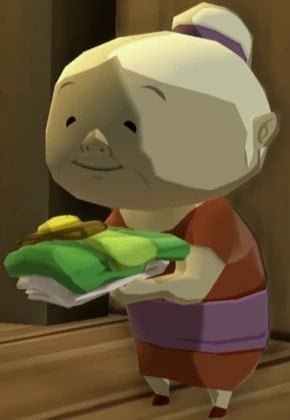
Source: Zelda Wiki
That’s the most interesting aspect of The Wind Waker’s story, in my opinion. Link starts the game as a random kid in green clothes. Being a sequel to Ocarina of Time set on a different timeline — which is a whole can of worms on its own — the plight at the beginning of The Wind Waker is that the citizens of Hyrule were waiting for The Hero of Time to return and he never did. As such, the gods of Hyrule deemed that for its people to live on, it needed to flood the lands to flush out the evil that was festering. That’s a ridiculously huge leap of logic to make, but we measly peasants would never understand the will of the gods.
Anyway, on Link’s home of Outset Island, it became customary to gift boys a green tunic when they came of age. Since The Wind Waker starts with Link’s birthday, he is finally old enough to take up that tradition and start his search for the fabled Master Sword. Before any of this can happen, however, Link’s sister is captured and he races off to save her… sort of. Some pirates stop Link from being a complete fool, but this hero is different from past Links. He doesn’t have the Triforce of Courage or some special god-like powers: he just wants to save his family.
To me, this makes The Wind Waker’s Link more relatable. While everyone loves a classic Hero’s Journey story, it’s nice to have some of the elements mixed up from time to time. Nintendo had reached a point in The Legend of Zelda’s history where it felt that the tried-and-true prophecy angle wasn’t applicable anymore. To create that more personal element, this Link was divorced from prophecy and made a simple boy venturing out into the wilds.
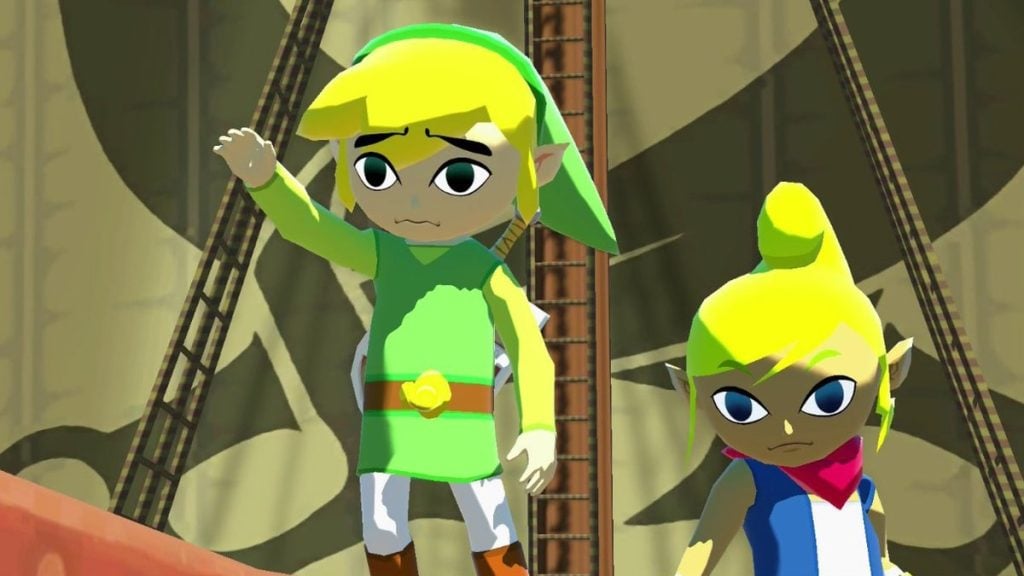
Fans will know that this Link eventually does rebuild the Triforce of Courage (which is a very clear nod to the original The Legend of Zelda on NES) and the gods deem him worthy of legend, but this twist on Link’s character casts the entirety of The Wind Waker’s story in a new light. Another significant change is to Zelda, who doesn’t even start as Zelda within the story.
When players first meet the girl who will become a princess, she is a brave and feisty pirate known as Tetra. She runs a ragtag crew of misfits that sail the seas of Hyrule in search of treasure. They aid Link on his journey to save his sister and along the way, it eventually is revealed that Tetra is the destined princess of the kingdom. While her story bears a resemblance to past incarnations of Zelda, her greater agency gives her more of a purpose within this particular narrative. She isn’t just a damsel for Link to save, but an integral part of his journey to becoming a noble hero.
The Wind Waker does stumble a little here by having Tetra’s transformation turn her into a passive figure for most of the second half of the game, but she eventually rejects tradition and helps Link defeat Ganondorf when the time comes. Speaking of which, I think we all need to give it up for the most silently brutal iteration of Link’s greatest foe. Being a sequel to Ocarina of Time, this Ganondorf already has a history of failing to stop Link and Zelda. While he knows that these two children are not the same foes he once faced, he isn’t going to leave anything to chance.
I suppose tossing Link into the sea and not checking if he died is a little foolish, but Ganondorf takes no prisoner here. When the opportunity presents itself, he snatches Zelda and forces Link to come to him. He manipulates The Helmaroc King into doing his bidding and he even causes problems around the various major islands of Hyrule. He wants Link distracted and tired so that when their duel inevitably comes, he’ll emerge victorious.
Things almost go Ganondorf’s way, too. It’s his hubris that gets the better of him. That kind of cockiness isn’t rare for Ganondorf, but to see the villain nearly snatch victory is a surprising turn for a Zelda game. When King Hyrule does claim the Triforce for himself, Ganondorf snaps and becomes determined to obliterate Link and Zelda at all costs. It creates a climactic battle for the ages.
All of this is stuff that I missed when I was younger. When The Wind Waker was released, I was 15 years old and more interested in generic triple-A games with violence and open worlds. It was such a new thing at the time that a lot of traditional games seemed boring to me. In my mind, nothing would ever top Ocarina of Time, so I kind of wrote off this new cel-shaded adventure as a bit of a misfire. Years later, I came to find a story that attempted to break new ground, a bold graphical style that put character emotion front and center, and a series of incredible side quests that took Link to every corner of this new Hyrule.
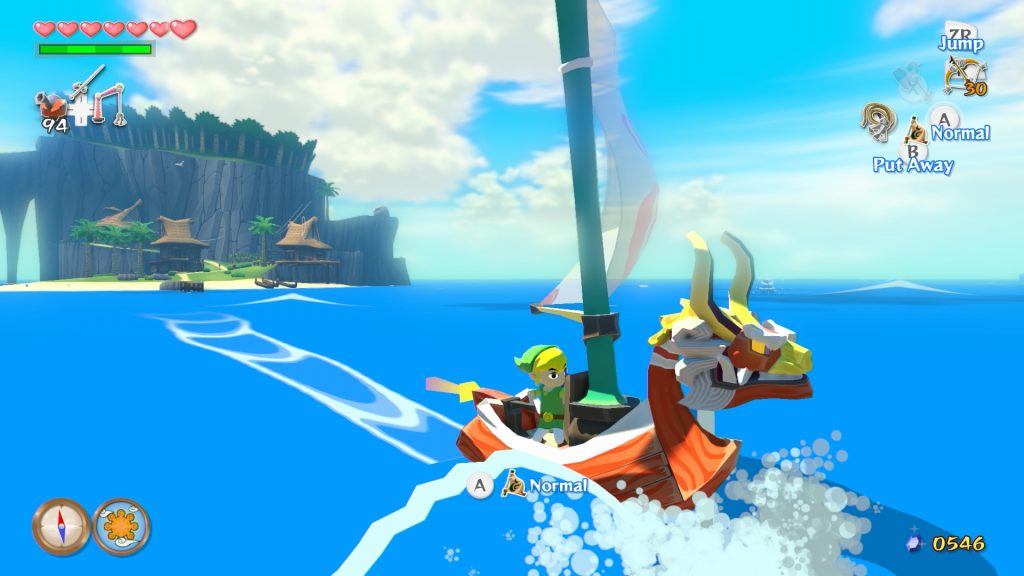
That’s not to say there aren’t some missteps along the way. While dungeons have remained my favorite aspect of any Legend of Zelda installment, The Wind Waker has mostly average dungeon designs. They are a little overly linear and the lack of any true difficulty makes the proceedings feel as if you’re going through the motions. It’s only within the confines of The Wind Temple that the designers truly exploit what Zelda is capable of. It certainly is fun to traverse dungeons with a buddy in tow.
There is also the infamous Triforce Shard quest, which drags out the length of the game due to Nintendo fearing The Wind Waker was too short. While it makes sense from a thematic and narrative standpoint, no one enjoys fishing through the Great Sea to find very specifically placed chests that contain one-eighth of the items that you need. The Wii U port would rectify some of this, but it’s still an odd inclusion as a late-game activity for what is otherwise a briskly paced seafaring adventure.
Even with those drawbacks, the Hyrule that inhabits The Wind Waker is one of the most welcoming and brightest worlds in the series’ history. While I appreciate that both Switch games have taken something of a darker turn for Zelda without becoming parodies of themselves, I do feel that The Wind Waker captures the exuberance that Miyamoto likely felt as a child exploring caves in Japan. When you’re a kid, you don’t have much of an idea of how the world really works. Everything seems fresh and inviting because you haven’t had many negative experiences. The whole idea behind The Legend of Zelda is to capture the essence of exploration through the view of a child and The Wind Waker does just that.
It might have some restrictions when it comes to progression through its game world and the dungeons are very limited when it comes to solutions, but the side quests here are incredible. They show so many different sides of the NPCs and Link that you grow to love simply existing within this world. Link gets his own island and home. You get to sail across Hyrule and plant flowers. There is a goofy Battleship-inspired minigame. The Wind Waker feels positively packed to the brim with stuff to do.
That joy and wonder is what made The Wind Waker stick out to me. It doesn’t hurt that Link is so expressive and the visuals so wonderfully realized that even playing the GameCube original still looks majestic. The Wii U version is certainly higher resolution and sharper, but the flat shading of the original is timeless. I don’t know that any other use of cel-shading has ever passed Nintendo’s efforts.
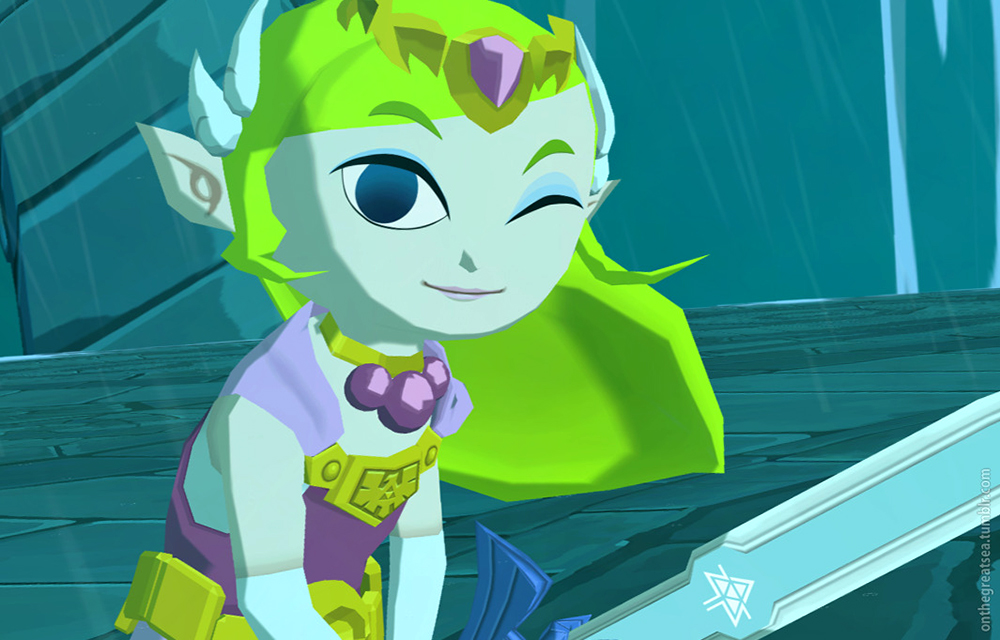
I honestly could ramble on for days about why this game is so fantastic. For the sake of brevity, I’ll leave you with another personal tidbit from my life regarding The Wind Waker. For a brief period when I was 25, I suffered from some terrible depression and was frequenting bars looking to dull the pain. I would eventually wind up spending time with a group of people who, while maybe not the best of people, had a keen understanding of video games and what made them special.
One of the guys had me pegged so well that from how I spoke and carried myself, he was able to tell I enjoyed The Legend of Zelda. He was even spot on with assuming The Wind Waker was my favorite game in the series. He proceeded to say to me that the overall message of The Wind Waker was that fate does not determine our lives. All of the characters here are fighting against fate, be it Link proving he isn’t just a pre-destined hero, Zelda subverting her expectations as a princess, or Ganondorf not wishing to remain the threat that Link always defeats. While he could have treated me much better than he did, I never forgot his summary.
The Wind Waker was Nintendo attempting something wildly different with The Legend of Zelda for the first time in ages. While it didn’t stick thanks to fan expectations in the early-2000s, Nintendo would never forget the lessons it learned here. Our current iteration of Zelda with Breath of the Wild and Tears of the Kingdom wouldn’t exist without this first attempt, which is probably why the Rito are so prominent in its world.
It’s still uncertain if Nintendo will ever return to the more structured approach of past Legend of Zelda games. The newer Switch installments have both become the highest-selling games in the entire series and appeal to a far greater audience than ever before. Still, if there is one thing that The Legend of Zelda has never been afraid of, it’s fully committing to a concept that might alienate some fans. Wherever this series does go, it will always remain a brave, bold, and bright one.
Leave a Comment
